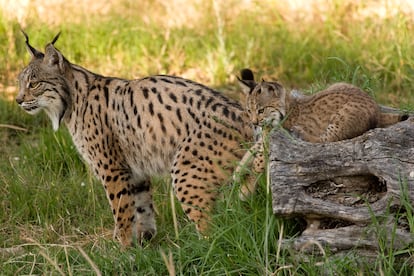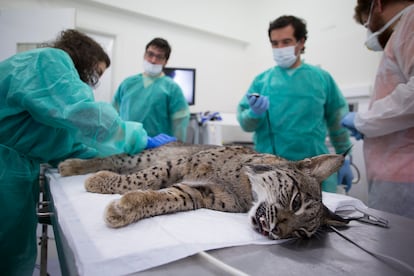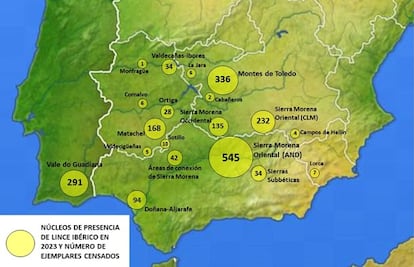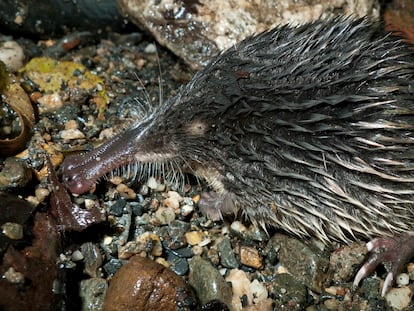The Iberian lynx rebounds in a milestone for conservation in Europe
The IUCN has changed the feline’s status from Endangered to Vulnerable. We spoke with some of the people who brought lynxes back from the brink of extinction through decades of uphill work

Twenty-three years have elapsed since Spain undertook the rescue of the Iberian lynx (Lynx pardinus), which was in a terminal state, with only 94 individuals left in two separate populations, both in the southern region of Andalusia: 54 in Andújar (Jaén province) and 40 in Doñana (Huelva province). Currently that number has risen to more than 2,000 lynxes, among which there are 648 mature individuals, which has led the International Union for Conservation of Nature (IUCN), the highest scientific authority on the environment, to change the conservation status of the feline from Endangered to Vulnerable. There are several factors behind the success, such as an increase in the rabbit population, its preferred food, the improvement of the natural habitat, the reduction of deaths caused by man, captive breeding, and the release of specimens into the wild.
It is the second time that the IUCN has upgraded the feline’s status: in 2015 it went from being considered Critically Endangered to Endangered. Despite impressive progress, the lynx continues to face threats, experts warn, especially due to fluctuations in the rabbit population, which is easily decimated by diseases. The paradox is that, at this time, the IUCN has established that the wild rabbit is more endangered than the lynx.
The hard beginnings

“It is very positive news, but no one gets medals, this has happened thanks to a team of more than 100 people,” says Miguel Ángel Simón, director of the feline’s conservation projects for two decades until his retirement in 2019. He recalls that the beginnings were “not bad, they were horrible, for three reasons: the lack of funding, that the few individuals that remained were living on private estates and cooperation from the owners was needed, and the lack of similar experiences in the world.” It was a matter of trial and error. Simón obtained European financing through the Life programs, which represented a turning point and an injection of millions of euros. Currently, there are four captive breeding centers, one of them in Portugal.
“Yes, the beginnings were hard, but we couldn’t waste time, there was a system to change and that was a lot of work, and we also had to learn how to support them in captivity and prepare the kittens to live in nature,” recalls Astrid Vargas, who directed the captive breeding program for the Iberian lynx from 2003 to 2010. The efforts ultimately bore fruit. On March 28, 2005, Saliega, a female from the Sierra Morena population, gave birth to the first litter born in captivity. “The image of the three kittens went around the world,” says Vargas.
The great expansion
Ramón Pérez de Ayala, from the conservation organization WWF, was also involved in the conservation of the species. He explains that the first releases occurred in 2011. Since then, more than 400 specimens have been released in Spain and Portugal, occupying a range of at least 3,320 square kilometers; In 2005 it was only 49 square kilometers, said the IUCN in a statement. The great expansion occurred in 2014, adds Pérez de Ayala, with the release of lynxes in the Montes de Toledo, where the population has grown spectacularly, in Sierra Morena Oriental, in the Matachel valley (Extremadura) and in the valley of Guadiana (Portugal). “The first three years were of moderate growth, until the females born in the wild began to breed and, around 2017, exponential growth began,” he points out.

In 2009, an invisible enemy attacked the Iberian lynx in captivity. Chronic kidney disease (CKD) began to wipe out specimens for unknown reasons. “The problem was a vitamin supplement that was poorly formulated, it contained 20 times more vitamin D than what the package indicated and caused excess calcium in the blood and damaged their kidneys,” explains Vargas. At first they did not suspect the compound, “because we had been administering it for years.” About 20 animals died and many others suffered kidney problems.
In nature, it was feline leukemia ― transmitted by cats ― that killed specimens. The problem was very concerning, especially in Doñana. In addition, the animals were without rabbits, who were dying from myxomatosis and hemorrhagic disease, both of viral origin.
A connected future
Despite the great progress made, the lynx has not yet reached a favorable status, so it is necessary to continue with the creation of new nuclei that will allow a connection between populations, something that is underway with the Life Lynx Connect program, which has received €18.7 million in funding over five years, ending in 2026. It is estimated that to achieve this, 750 breeding females are needed and in the last census of 2003, only 406 were detected. “To avoid inbreeding, we should have about 1,100 reproductive females and eight new populations,” says José Antonio Godoy, a researcher at the Doñana Biological Station, who has been working with the species for 20 years.
Another problem yet to be solved is roadkill deaths: last year these affected 7% of the population.
Sign up for our weekly newsletter to get more English-language news coverage from EL PAÍS USA Edition
Tu suscripción se está usando en otro dispositivo
¿Quieres añadir otro usuario a tu suscripción?
Si continúas leyendo en este dispositivo, no se podrá leer en el otro.
FlechaTu suscripción se está usando en otro dispositivo y solo puedes acceder a EL PAÍS desde un dispositivo a la vez.
Si quieres compartir tu cuenta, cambia tu suscripción a la modalidad Premium, así podrás añadir otro usuario. Cada uno accederá con su propia cuenta de email, lo que os permitirá personalizar vuestra experiencia en EL PAÍS.
¿Tienes una suscripción de empresa? Accede aquí para contratar más cuentas.
En el caso de no saber quién está usando tu cuenta, te recomendamos cambiar tu contraseña aquí.
Si decides continuar compartiendo tu cuenta, este mensaje se mostrará en tu dispositivo y en el de la otra persona que está usando tu cuenta de forma indefinida, afectando a tu experiencia de lectura. Puedes consultar aquí los términos y condiciones de la suscripción digital.
More information
Archived In
Últimas noticias
Most viewed
- Reinhard Genzel, Nobel laureate in physics: ‘One-minute videos will never give you the truth’
- Oona Chaplin: ‘I told James Cameron that I was living in a treehouse and starting a permaculture project with a friend’
- Pablo Escobar’s hippos: A serious environmental problem, 40 years on
- Charles Dubouloz, mountaineering star, retires at 36 with a farewell tour inspired by Walter Bonatti
- Why we lost the habit of sleeping in two segments and how that changed our sense of time











































